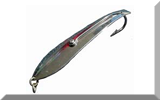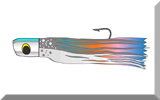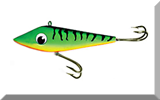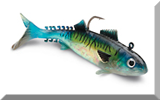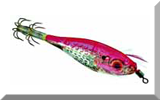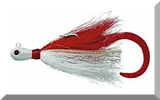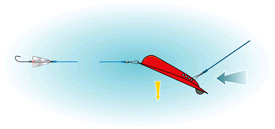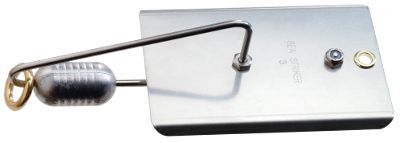Use a Trolling Paravane - or Maybe a Planer - to Get Your Lure Down Deeper
A trolling paravane is a plastic device that works like an inverted wing, diving deeper as boat speed increases and dragging your lure down to a greater depth than it would otherwise achieve.
They're attached between the main line and the leader, where your trolling sinker would otherwise be.
On some models, like the one shown here, there's a choice of attachment positions, the furthest aft producing the steepest diving angle and vice versa.
Similarly, there's a choice of attachment points on the trailing edge, which can be used to pull the lure off to port or starboard - very useful to get some separation when trolling two lines.
The leader should be around 7m (23 feet) long to prevent the turbulence created by the device from spooking the fish.
Most paravane designs are ballasted by a moulded lead weight attached to the forward end.
They capsize when a fish strikes the lure, converting the dive effect to climb , which brings the fish to the surface where you''ll see it splashing about astern.
They're at their best when trolling small lures at moderate speeds.
The smaller 50g versions are best for trolling light lures at around 2knots or so, while the larger 150g versions work well at up to 5knots or so and will your lure down deeper.
But they have their limitations; tow them too quickly and they'll become unstable and capsize, and similarly, the drag of too large a lure will immediately cause them to trip.
So then, what now?
Use a planer!
Planers are bigger, heavier and more powerful than their plastic cousins - and dive deeper as a result. You can troll them at much higher speeds and use them with larger offshore lures. And similarly, the faster you troll them the deeper they dive. But only up to a point, after which they call time and dive no further.
A planer will normally set in the dive position upon entering the water, but if it doesn't, or trips unaccountably, it can be reset without having to bring it back in again.
Just snatch in a couple of metres then quickly release it. The resultant slack in the line should allow the planer to nosedive and reset itself. Use the same technique to trip it for retrieval.
Planers of any size can be used with a handline but only the smallest models can be used with a rod, owing to the considerable drag they create. Even so, you may well have to bring the boat to a near-stop before you can haul them in by hand. Consequently, the larger planers are best used with downrigger gear. |
